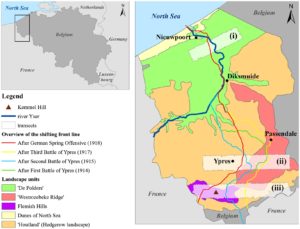
(Landscape Research, 2018)
Using the past to indicate the possible presence of relics in the present-day landscape: the Western Front of the Great War in Belgium
The First World War (WWI) had a notable influence on the landscape at the former Western Front in Belgium. Research on a landscape scale is necessary to understand the destructive and constructive impact of the war and its consequences for the post-war landscape in a holistic manner. This paper focuses on the trajectory and impact analysis of three study areas with contrasting landscape types and aims to indicate possible preserved military relics today. Therefore, landscape changes are studied using historical aerial photographs (WWI and WWII) and contemporary orthophotos. A military landscape characterisation is made based on land use/land cover and linear structures that were mapped throughout time. Specific landscape trajectories could be designated as areas with a possible preservation of WWI heritage, with a related impact degree. The results are useful for sustainable heritage management and for further interdisciplinary research on WWIheritage, by providing a broad knowledge of the area.
Reference:
Van den Berghe, H., Gheyle, W., Stichelbaut, B., Saey, T., Note, N., Van Meirvenne, M., Bourgeois, J., & Van Eetvelde, V. (2018). Using the past to indicate the possible presence of relics in the present-day landscape: the Western Front of the Great War in Belgium. Landscape Research
http://www.tandfonline.com/doi/full/10.1080/01426397.2017.1415315
Link to free e-print (PDF): https://www.tandfonline.com/eprint/N62zwbZvAVcIsZba2X6Q/full